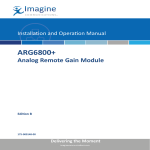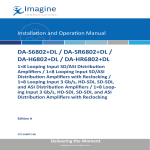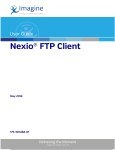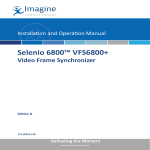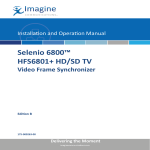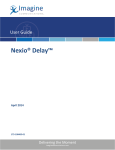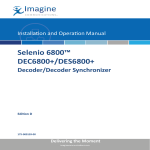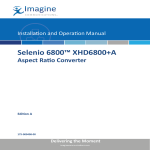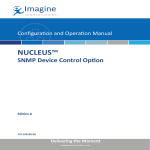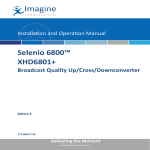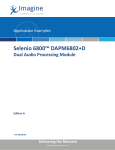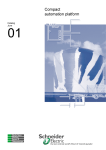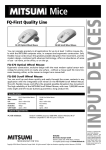Download DA-ASI6802+ Installation and Operation Manual
Transcript
Installation and Operation Manual DA-ASI6802+: 1×8 ASI Distribution Amplifiers Edition A 175-100028-00 Delivering the Moment Publication Information © 2014 Imagine Communications Corp. Proprietary and Confidential. Imagine Communications considers this document and its contents to be proprietary and confidential. Except for making a reasonable number of copies for your own internal use, you may not reproduce this publication, or any part thereof, in any form, by any method, for any purpose, or in any language other than English without the written consent of Imagine Communications. All others uses are illegal. This publication is designed to assist in the use of the product as it exists on the date of publication of this manual, and may not reflect the product at the current time or an unknown time in the future. This publication does not in any way warrant description accuracy or guarantee the use for the product to which it refers. Imagine Communications reserves the right, without notice to make such changes in equipment, design, specifications, components, or documentation as progress may warrant to improve the performance of the product. Trademarks 6800+™, ADC™, CCS Navigator™, Channel ONE™, ChannelView™, ClipSync™, Delay™, D Series™, D Series DSX™, Deliver the Moment™, Delivering the Moment™, FAME™, Farad™, G8™, G Scribe™, HView™, IconMaster™, IconLogo™, IconStation™, IconKey™, InfoCaster™, InfoCaster Creator™, InfoCaster Manager™, InfoCaster Player™, InstantOnline™, Invenio®, Live Update™, mCAPTURE™, Magellan™, Magellan CCS Navigator™, Magellan Q SEE™, MultiService SDN™, NetPlus™, NetVX™, NewsForce™, Nexio® G8™, Nexio AMP® ChannelView™, Nexio® Channel ONE™, Nexio® ClipSync™, Nexio® Delay™, Nexio® Digital Turnaround Processor™, Nexio® Farad™, Nexio® G Scribe™, Nexio® IconKey™, Nexio® IconLogo™, Nexio® IconMaster™, Nexio® IconStation™, Nexio® InfoCaster™, Nexio® InfoCaster Creator™, Nexio® InfoCaster Manager™, Nexio® InfoCaster Player™, Nexio® InfoCaster Traffic™, Nexio® InstantOnline™, Nexio® mCAPTURE™, Nexio® NewsForce™, Nexio® NXIQ™, Nexio® Playlist™, Nexio® Remote™, Nexio®RTX Net™, Nexio® TitleMotion™, Nexio® TitleOne™, Nexio® Velocity ESX™, Nexio® Velocity PRX™, Nexio® Velocity XNG™, Nexio® Volt™, OPTO+™, Panacea™, Platinum™, Playlist™, Predator II GRF™, Predator II GX™, Punctuate™, Remote™, RTX Net™, QuiC™, Q SEE™, SD STAR™, Selenio™, Selenio 6800+™, SelenioNext™, Selenio X50™, Selenio X85™, Selenio X100™, TitleMotion™, TitleOne™, Velocity ESX™, Velocity PRX™, Velocity XNG™, Versio™, Videotek® SD STAR™, X50™, and X85™ are trademarks of Imagine Communications or its subsidiaries. Altitude Express®, Connectus®, Enabling PersonalizedTV®, ICE® Broadcast System, ICE Illustrate®, ICE Q® algorithms, ICEPAC®, Imagine ICE®, Inscriber®, Inscriber® Connectus®, Invenio®, NEO®, Nexio®, Nexio AMP®, PersonalizedTV®, RouterWorks®, Videotek®, Videotek® ASI STAR®, Videotek® GEN STAR®, and Videotek® HD STAR® are registered trademarks of Imagine Communications or its subsidiaries. Microsoft® and Windows® are registered trademarks of Microsoft Corporation. HD BNC is a trademark of Amphenol Corporation. Some products are manufactured under license from Dolby Laboratories. Dolby and the double D symbol are registered trademarks of Dolby Laboratories. DTS Neural audio products are manufactured under license from DTS Licensing Limited. DTS and the Symbol are registered trademarks & the DTS Logos are trademarks of DTS, Inc. © 2008 2010 DTS, Inc. All other trademarks and trade names are the property of their respective companies. Contact Information Imagine Communications has office locations around the world. For locations and contact information see: http://www.imaginecommunications.com/contact us/ Support Contact Information For support contact information see: ▪▪ ▪▪ Support Contacts: http://www.imaginecommunications.com/services/technical support/ eCustomer Portal: http://support.imaginecommunications.com © 2014 Imagine Communications Corp. Proprietary and Confidential DA-ASI802+ 1×8 ASI Distribution Amplifiers Installation and Operation Manual Edition A December 2008 Preliminary—Contents are proprietary and confidential. Do not photocopy or distribute. Contents Preface Manual Information .............................................................................................vii Purpose .........................................................................................................vii Audience .......................................................................................................vii Revision History ...........................................................................................vii Writing Conventions ...................................................................................viii Obtaining Documents ..................................................................................viii Unpacking/Shipping Information ......................................................................... ix Unpacking a Product ..................................................................................... ix Product Servicing .......................................................................................... ix Returning a Product ....................................................................................... ix Safety Standards and Compliances ....................................................................... x Safety Terms and Symbols ............................................................................. x Restriction on Hazardous Substances (RoHS) Directive .............................. xi Waste from Electrical and Electronic Equipment (WEEE) Directive ........................................................................................xii Chapter 1: Introduction Overview ................................................................................................................ 1 Product Description ............................................................................................... 2 Main Features ................................................................................................. 2 Typical Broadcast and Production Applications ............................................ 2 Module Descriptions ............................................................................................. 3 Front Module .................................................................................................. 3 Back Modules ................................................................................................. 3 Signal Flow ............................................................................................................ 4 Chapter 2: Installation Overview ................................................................................................................ 5 Maximum 6800+ Frame Power Ratings ............................................................... 6 Unpacking the Module .......................................................................................... 7 Preparing for Installation ................................................................................ 7 Checking the Packing List .............................................................................. 7 Setting Jumpers ...................................................................................................... 7 Setting J1 Jumpers .......................................................................................... 7 DA-ASI6802+ Installation and Operation Manual Copyright © 2008, Harris Corporation iii Preliminary—Contents are proprietary and confidential. Do not photocopy or distribute. Contents Installing 6800+ Modules ...................................................................................... 8 Required Frames and Back Module Connector Types ................................... 8 Installing Modules .......................................................................................... 8 Removing Modules ........................................................................................ 8 Making Connections............................................................................................... 8 Chapter 3: Operation Overview ................................................................................................................ 9 Operating Notes ................................................................................................... 10 Understanding Jumper Controls ........................................................................... 10 Introducing Jumper Control Types .............................................................. 10 J1 Jumpers .................................................................................................... 10 Understanding Parameter Types........................................................................... 11 Adjustable Parameters .................................................................................. 11 Read-Only Parameters .................................................................................. 11 Setting Locally Controlled Parameters ................................................................ 12 Local Control Reclocking Mode .................................................................. 12 Setting Remotely Controlled Parameters ............................................................ 13 Changing Parameter Settings Using CCS Software ............................................ 14 Changing Parameters Using CCS Software ................................................. 14 Recalling Default Parameter Settings .......................................................... 14 Reading Software and Hardware Versions .................................................. 15 LEDs and Alarms ................................................................................................. 15 Module Status Indicator LED ...................................................................... 15 Module-Specific LEDs ................................................................................. 16 Alarms .......................................................................................................... 17 Chapter 4: Specifications Overview .............................................................................................................. 19 Inputs ................................................................................................................... 20 Outputs ................................................................................................................. 20 Performance ......................................................................................................... 21 Power Consumption ............................................................................................. 21 Temperature ......................................................................................................... 21 Start-Up Time ...................................................................................................... 21 Appendix A: Troubleshooting Overview ............................................................................................................. 23 General Troubleshooting Steps ........................................................................... 24 Control and Monitoring Using CCS Software .................................................... 25 Refreshing Your Module Using + Pilot Lite ............................................... 25 Discovering Your Module Using CCS Software ......................................... 25 Software Communication and Control Issues ..................................................... 26 + Pilot Lite Fails to Communicate with Installed Modules ......................... 26 + Pilot Lite Does Not Find All Modules in Frame ...................................... 27 iv DA-ASI6802+ Installation and Operation Manual Copyright © 2008, Harris Corporation Preliminary—Contents are proprietary and confidential. Do not photocopy or distribute. Contents + Pilot Lite or CCS Software Application Not Responding ........................ 27 + Pilot Lite Cannot Control a Module Showing in the Control Window ................................................................................. 28 + Pilot Lite Status Bar Reports ‘Not Ready’ Status .................................... 28 CCS Software Application or Remote Control Panel Does Not Communicate with Module .......................................................... 28 Alarm Query Fails When a Device Reboots ................................................ 28 Hardware Communication and Control Issues .................................................... 29 Frame Fails to Communicate with the PC After a Power Failure ................ 29 Module Does Not Seem to Work ................................................................. 29 Contacting Customer Service ............................................................................... 29 Index Keywords ............................................................................................................. 31 DA-ASI6802+ Installation and Operation Manual Copyright © 2008, Harris Corporation v Preliminary—Contents are proprietary and confidential. Do not photocopy or distribute. Contents vi DA-ASI6802+ Installation and Operation Manual Copyright © 2008, Harris Corporation Preliminary—Contents are proprietary and confidential. Do not photocopy or distribute. Preface Manual Information Purpose This manual details the features, installation procedures, operational procedures, and specifications of the DA-ASI6802+ 1×8 ASI distribution amplifier Audience This manual is written for engineers, technicians and operators responsible for the installation, setup, and / or operation of the DA-ASI6802+ 1×8 ASI distribution amplifier. Revision History Table 3-1. Manual Revision History Edition Date A December 2008 Initial release DA-ASI6802+ Installation and Operation Manual Copyright © 2008, Harris Corporation Revision History vii Preliminary—Contents are proprietary and confidential. Do not photocopy or distribute. Preface Writing Conventions To enhance your understanding, the authors of this manual have adhered to the following text conventions: Table 3-2. Manual Style and Writing Conventions Term or Convention Description Bold Indicates dialog boxes, property sheets, fields, buttons, check boxes, list boxes, combo boxes, menus, submenus, windows, lists, and selection names. Italics Indicates email addresses, the names of books or publications, and the first instances of new terms and specialized words that need emphasis. CAPS Indicates a specific key on the keyboard, such as ENTER, TAB, CTRL, ALT, or DELETE. Code Indicates variables or command-line entries, such as a DOS entry or something you type into a field. > Indicates the direction of navigation through a hierarchy of menus and windows. hyperlink Indicates a jump to another location within the electronic document or elsewhere Internet address Indicates a jump to a website or URL Indicates important information that helps to avoid and troubleshoot problems. Obtaining Documents Product support documents can be viewed or downloaded from our website. Alternatively, contact your Customer Service representative to request a document. viii DA-ASI6802+ Installation and Operation Manual Copyright © 2008, Harris Corporation Preliminary—Contents are proprietary and confidential. Do not photocopy or distribute. Preface Unpacking/Shipping Information Unpacking a Product This product was carefully inspected, tested, and calibrated before shipment to ensure years of stable and trouble free service. 1. Check equipment for any visible damage that may have occurred during transit. 2. Confirm that you have received all items listed on the packing list. 3. Contact your dealer if any item on the packing list is missing. 4. Contact the carrier if any item is damaged. 5. Remove all packaging material from the product and its associated components before you install the unit. Product Servicing DA-ASI6802+ modules are not designed for field servicing. All hardware and firmware upgrades, modifications, or repairs require you to return the modules to the Customer Service center. Returning a Product In the unlikely event that your product fails to operate properly, please contact Customer Service to obtain a Return Authorization (RA) number, then send the unit back for servicing. Keep at least one set of original packaging, in the event that you need to return a product for servicing. If the original packaging is not available, you can purchase replacement packaging at a modest cost or supply your own packaging as long as it meets the following criteria: • Withstands the weight of the product • Holds the product rigid within the packaging • Leaves at least two inches of space between the product and the container • Protects the corners of the product Ship products back to us for servicing prepaid and, if possible, in the original packaging material. If the product is still within the warranty period, we will return the product prepaid after servicing. DA-ASI6802+ Installation and Operation Manual Copyright © 2008, Harris Corporation ix Preliminary—Contents are proprietary and confidential. Do not photocopy or distribute. Preface Safety Standards and Compliances See the 6800+ Safety Instructions and Standards Manual to find the safety standards and compliances for this 6800+ series product. A safety manual is shipped with every FR6802+ Frame Installation and Operation Manual and can be downloaded from our website. Alternatively, contact your Customer Service representative for a copy of this safety manual. Safety Terms and Symbols This product manual uses the following safety terms and symbols to identify certain conditions or practices. See the 6800+ Safety Instructions and Standards Manual for more information. Table 3-3. Safety Terms and Symbols Symbol Description WARNING Identifies conditions or practices that can result in personal injury or loss of life—high voltage is present. Uninsulated dangerous voltage within the product’s enclosure may be sufficient to constitute a risk of electric shock to persons. CAUTION Identifies conditions or practices that can result in damage to the equipment or other property. Important operating and maintenance (servicing) instructions are included in the literature accompanying the product. x DA-ASI6802+ Installation and Operation Manual Copyright © 2008, Harris Corporation Preliminary—Contents are proprietary and confidential. Do not photocopy or distribute. Preface Restriction on Hazardous Substances (RoHS) Directive Directive 2002 / 95 / EC—commonly known as the European Union (EU) Restriction on Hazardous Substances (RoHS)—sets limits on the use of certain substances found in electrical and electronic equipment. The intent of this legislation is to reduce the amount of hazardous chemicals that may leach out of landfill sites or otherwise contaminate the environment during end-of-life recycling. The Directive, which took effect on July 1, 2006, refers to the following hazardous substances: • Lead (Pb) • Mercury (Hg) • Cadmium (Cd) • Hexavalent Chromium (Cr-V1) • Polybrominated Biphenyls (PBB) • Polybrominated Diphenyl Ethers (PBDE) In accordance with this EU Directive, products sold in the European Union will be fully RoHS-compliant and “lead-free.” (See our website for more information.) Spare parts supplied for the repair and upgrade of equipment sold before July 1, 2006 are exempt from the legislation. Equipment that complies with the EU directive will be marked with a RoHS-compliant symbol, as shown in Figure P-3-1. Figure 3-1. RoHS Compliance Symbol DA-ASI6802+ Installation and Operation Manual Copyright © 2008, Harris Corporation xi Preliminary—Contents are proprietary and confidential. Do not photocopy or distribute. Preface Waste from Electrical and Electronic Equipment (WEEE) Directive The European Union (EU) Directive 2002 / 96 / EC on Waste from Electrical and Electronic Equipment (WEEE) deals with the collection, treatment, recovery, and recycling of electrical and electronic waste products. The objective of the WEEE Directive is to assign the responsibility for the disposal of associated hazardous waste to either the producers or users of these products. As of August 13, 2005, producers or users are required to recycle electrical and electronic equipment at end of its useful life, and must not dispose of the equipment in landfills or by using other unapproved methods. (Some EU member states may have different deadlines.) In accordance with this EU Directive, companies selling electric or electronic devices in the EU will affix labels indicating that such products must be properly recycled. (See our website for more information.) Contact your local Sales representative for information on returning these products for recycling. Equipment that complies with the EU directive will be marked with a WEEE-compliant symbol, as shown in Figure P-3-2. Figure 3-2. WEEE Compliance Symbol xii DA-ASI6802+ Installation and Operation Manual Copyright © 2008, Harris Corporation Preliminary—Contents are proprietary and confidential. Do not photocopy or distribute. Chapter 1 Introduction Overview The following topics are described in this chapter: • “Main Features” on page 2 • “Module Descriptions” on page 3 • “Product Description” on page 2 • “Signal Flow” on page 4 DA-ASI6802+ Installation and Operation Manual Copyright © 2008, Harris Corporation 1 Preliminary—Contents are proprietary and confidential. Do not photocopy or distribute. Chapter 1: Introduction Product Description The DA-ASI6802+ distribution amplifiers are designed to distribute serial digital video signals according to SMPTE 257C, DVB, and other related standards. They feature high reliability, excellent video performance, and low cost. You can can control and monitor these distribution amplifier modules locally (via jumpers and card-edge LEDs) or remotely (via RS-232 ports or optional ICE6800+ and 6800+ETH Ethernet connection). Main Features • • • • • • • • One input, eight outputs Input signal presence detect and report Automatic input cable equalization Automatic reclocking 270 Mb/s DVB-ASI Reclock status and rate report by LEDs Automatic bypass reclocking stage if not relockable Card edge control by jumpers with LED display Remote monitoring via RS-232 or Ethernet Typical Broadcast and Production Applications DA-ASI6802+ distribution amplifiers can be used in broadcast, cable, production, educational, and auditorium applications where high performance SD-SDI signal distribution is required. 2 DA-ASI6802+ Installation and Operation Manual Copyright © 2008, Harris Corporation Preliminary—Contents are proprietary and confidential. Do not photocopy or distribute. Chapter 1: Introduction Module Descriptions Front Module Figure 1-1 is a generic top-front view of a typical front module. See Figure 3-2 on page 20 and Figure 3-3 on page 21 for LED locations. Figure 1-1. Typical Front Module Back Modules DA-ASI6802+ modules can be installed with double-width (1×8) back modules in FR6802+QX(F) and FR6802+DM frames. These modules cannot be installed in 6800 / 7000 series frames. FR6802+ Frame Back Module Figure 1-2 on page 3 shows the double-width back connector module used by the DA-ASI6802+ when installed in an FR6802+XF, FR6802+QXF, or FR6802+DM frame. Figure 1-2. Double-Width Back Module for FR6802+X(F) and FR6802+DM Frames DA-ASI6802+ Installation and Operation Manual Copyright © 2008, Harris Corporation 3 Preliminary—Contents are proprietary and confidential. Do not photocopy or distribute. Chapter 1: Introduction Signal Flow Figure 1-3. Signal Flow Diagram 4 DA-ASI6802+ Installation and Operation Manual Copyright © 2008, Harris Corporation Preliminary—Contents are proprietary and confidential. Do not photocopy or distribute. Chapter 2 Installation Overview This chapter describes the DA-ASI6802+ module’s installation process, including the following topics: • “Installing Modules” on page 8 • “Making Connections” on page 8 • “Maximum 6800+ Frame Power Ratings” on page 6 • “Removing Modules” on page 8 • “Required Frames and Back Module Connector Types” on page 8 • “Setting Jumpers” on page 7 • “Unpacking the Module” on page 7 See the FR6802+ Frame Installation and Operation Manual for information about installing and operating an FR6802+ frame and its components. CAUTION Before installing this product, read the 6800+ Series Safety Instructions and Standards manual shipped with every FR6802+ Frame Installation and Operation Manual, or downloadable from our website. This safety manual contains important information about the safe installation and operation of 6800+ series products. DA-ASI6802+ Installation and Operation Manual Copyright © 2008, Harris Corporation 5 Preliminary—Contents are proprietary and confidential. Do not photocopy or distribute. Chapter 2: Installation Maximum 6800+ Frame Power Ratings Power consumption information is listed in Chapter 4: “Specifications” on page 26. Table 2-1 describes the maximum allowable power ratings for 6800+ frames. Note the given maximums before installing any 6800+ modules in your frame. DA-ASI6802+ modules can be installed in FR6802+ frames. They cannot be installed in 6800 / 7000 series frames. Table 2-1. Maximum Power Ratings for 6800+ Frames Max. Frame 6800+ Frame Type Power Dissipation 6 No. Usable Slots Max. Power Dissipation Per Slot FR6802+XF (frame with AC power supply) 120 W 20 6W FR6802+XF48 (frame with DC power supply) 105 W 20 5.25 W FR6802+QXF (frame with AC or DC power supply) 120 W 20 6W DA-ASI6802+ Installation and Operation Manual Copyright © 2008, Harris Corporation Preliminary—Contents are proprietary and confidential. Do not photocopy or distribute. Chapter 2: Installation Unpacking the Module Preparing for Installation Before you install DA-ASI6802+ modules, perform the following: • Check the equipment for any visible damage that may have occurred during transit. • Confirm receipt of all items on the packing list. See “Checking the Packing List” on page 7 for more information. • Remove the anti-static shipping pouch, if present, and all other packaging material. • Retain the original packaging materials for possible re-use. • Contact your Customer Service representative if parts are missing or damaged. See “Unpacking/Shipping Information” on page ix for information about returning a product for servicing. Checking the Packing List Table 2-2. DA-ASI6802+ Packing List Ordered Product Content Description DA-ASI6802+ • One DA-ASI6802+ front module • One DA-ASI6802+ Installation and Operation Manual DA-ASI6802+ D • One DA-ASI6802+ front module • One double-slot back connector • One DA-ASI6802+ Installation and Operation Manual DA-ASI6802+DR • One standard double-slot back connector Setting Jumpers You need to configure modules for local or remote operation before power-up. To change the configuration, first remove power from the module, reset the jumper, and then reapply power. Setting J1 Jumpers The J1 jumper1 is used to select local control reclock settings. Follow this procedure to set the jumpers: 1. Locate the J1 jumper set on the module. Figure 2-1 shows the standard location of the jumper set. 2. Place a shunt on the pin that corresponds to the mode that you want. (See page 14 for a description of the J1 settings.) 1 Jumper selections for 1.5HD and 3.0HD are not operational on DA-ASI6802+ modules. DA-ASI6802+ Installation and Operation Manual Copyright © 2008, Harris Corporation 7 Preliminary—Contents are proprietary and confidential. Do not photocopy or distribute. Chapter 2: Installation J1 jumper Figure 2-1. J1 Jumper Set Locations Installing 6800+ Modules Required Frames and Back Module Connector Types These modules have double-width back connectors that can be installed in an FR6802+ series frame. See the FR6802+ Frame Installation and Operation Manual for details on installing back connectors in an FR6802+ frame. These modules cannot be installed in 6800 / 7000 series frames. Installing Modules These modules require no specialized installation procedures. See the FR6802+ Frame Installation and Operation Manual for information about installing and operating an FR6802+ frame and its components. Removing Modules These modules require no specialized removal procedures. See the FR6802+ Frame Installation and Operation Manual for information about removing components in an FR6802+ frame. Making Connections Once you have installed the module, you can connect it to the appropriate input and outputs. 8 DA-ASI6802+ Installation and Operation Manual Copyright © 2008, Harris Corporation Preliminary—Contents are proprietary and confidential. Do not photocopy or distribute. Chapter 3 Operation Overview This chapter describes how to operate DA-ASI6802+ modules using local controls only. See the following documents for information on how to operate this product remotely: • + Pilot Lite™ User Manual for serial control interface • CCS™ Navigator™, Pilot™, CoPilot™, or RCP-CCS-1U Remote Control Panel Installation and Operation Manual for Ethernet control interface The following topics are discussed in this chapter: • “Changing Parameter Settings Using CCS Software” on page 14 • “LEDs and Alarms” on page 15 • “Operating Notes” on page 10 • “Setting Remotely Controlled Parameters” on page 13 • “Understanding Parameter Types” on page 11 DA-ASI6802+ Installation and Operation Manual Copyright © 2008, Harris Corporation 9 Preliminary—Contents are proprietary and confidential. Do not photocopy or distribute. Chapter 3: Operation Operating Notes When you change a control parameter on a DA-ASI6802+ module, the effect is immediate. However, the module requires up to 20 seconds to save the latest change. After 20 seconds, the new settings are saved and will be restored if the module loses power and must be restarted. Understanding Jumper Controls Introducing Jumper Control Types J1 jumper Figure 3-1. Location of the Jumper Set J1 Jumpers You can use the J1 jumper to select local control reclock setting. Figure 3-1 on page 10 illustrates the location of this jumper. Note Jumper selections for 1.5HD and 3.0HD are not operational on DAASI6802+ modules. For local control, the J1 jumpers are used to determine reclocking mode. See “Setting Locally Controlled Parameters” on page 12. 10 DA-ASI6802+ Installation and Operation Manual Copyright © 2008, Harris Corporation Preliminary—Contents are proprietary and confidential. Do not photocopy or distribute. Chapter 3: Operation Understanding Parameter Types Most module parameters are adjustable, and can be set via a CCS software application (see “Setting Remotely Controlled Parameters” on page 13 and “Changing Parameter Settings Using CCS Software” on page 14). However, there are some parameters that are considered “read-only” and cannot be changed. Indicated by the abbreviation “[RO],” these parameters provide status and feedback information only. Harris recommends that you use the available 6800+ software control options (serial/local or Ethernet/remote) to aid in viewing, setting, and confirming parameter values. Adjustable Parameters Two types of adjustable parameters can be changed: • Numerical parameters require you to select a value within a numerical range. • Selectable parameters require you to select a specific option. Both numerical and selectable parameter changes are immediate. Use the available 6800+ software controls (serial / local or Ethernet / remote network) to view and monitor parameter selections. Read-Only Parameters These parameters provide status and feedback information only. They are represented by LEDs on the front of the module’s card edge. See Figure 3-2 on page 15 and Figure 3-3 on page 16 for the location of these LEDs. DA-ASI6802+ Installation and Operation Manual Copyright © 2008, Harris Corporation 11 Preliminary—Contents are proprietary and confidential. Do not photocopy or distribute. Chapter 3: Operation Setting Locally Controlled Parameters Local Control Reclocking Mode In the local control reclock setting operation mode, all of the settings’ data status information appears on the + Pilot Lite control screen; however, you cannot change any setting in this mode via + Pilot Lite. (To control the reclocking setting mode via + Pilot Lite, set the J1 jumper to the remote control reclock setting operation mode.) For local control, the J1 jumper is used to determine reclocking mode. Table 3-1 describes parameters that are accessible locally. Table 3-1. DA-ASI6802+ Local Control Reclock Modes 12 Reclock Mode Description AUTO (Default) Automatically detects the rate; if no selection rate jumpers are selected, the selection will be AUTO 270 Forces channel to lock to a 270 Mb/s signal Set the jumper on the pin that allows the reclocker to handle 270 Mb/s data only • If 270 reclock mode is selected, the 270 Mb/ s LED will turn on • If the module can successfully lock to the input, the lock LED will turn on • If reclocking is not successful, the lock LED will turn off and un-reclocked data will be present at output 1.5HD Not operational on DA-ASI6802+ modules 3.0HD Not operational on DA-ASI6802+ modules BYPASS Forces channel to bypass the reclocker REMOTE Selects reomote control operation DA-ASI6802+ Installation and Operation Manual Copyright © 2008, Harris Corporation Preliminary—Contents are proprietary and confidential. Do not photocopy or distribute. Chapter 3: Operation Setting Remotely Controlled Parameters Table 3-2 describes parameters that are accessible remotely. See your CCS control software application manual or online help for more information on setting and monitoring these parameters remotely. Legend Bold option=Indicates that this is the default setting for the parameter. [RO]=Indicates that parameters are read-only/feedback, and cannot be used to select controls. All parameters clip unless otherwise noted. t Table 3-2. DA-ASI6802+ Remotely Controlled Parameters Name Range Description Signal Present [RO] • 0=No • 1=Yes Indicates if input is present or not Loss of Input Alarm • 0=Disable Enables/disables Loss of Input alarm • 1=Enable Loss of Lock Alarm • 0=Disable Enables/disables Loss of Lock alarm • 1=Enable DA-ASI6802+ Installation and Operation Manual Copyright © 2008, Harris Corporation 13 Preliminary—Contents are proprietary and confidential. Do not photocopy or distribute. Chapter 3: Operation Changing Parameter Settings Using CCS Software You can change module parameter settings remotely by selecting the Loss of Input Alarm or Loss of Lock Alarm parameter setting. Changing Parameters Using CCS Software Before using CCS software applications to change your module’s parameter settings, you must refresh (+ Pilot Lite) or discover (Pilot and Navigator) the module. Refresh and Discovery are the processes by which your CCS software finds, and then connects to your module. Refreshing Your Module Using + Pilot Lite When using + Pilot Lite to change your module's control parameters, you must “refresh” the control connection between your 6800+ frame and PC. To refresh the connection, from the + Pilot Lite menu bar, select File > Refresh. For information about controlling a device using + Pilot Lite, see your + Pilot Lite User Manual. Discovering Your Module Using CCS Software To discover your DA-ASI6802+ modules, your Pilot or Navigator software must be in Build mode. Follow these steps: 1. If the Discovery window is not open, click Tools > Discovery in the main menu. A Discovery window opens, most likely in the bottom left corner of the screen. 2. Click Options, and then click Add. 3. Enter the IP address of the frame that contains your module, the frame that contains your ICE6800+ module, or the frame that contains a 6800+ETH module that provides access to your module. 4. Click OK to close the Add IP address window, and then OK again to close the Discovery Options window. 5. Click Start. This triggers Pilot or Navigator to run a discovery. 6. When your discovery is complete, Discovery Completed is displayed in the Discovery window. To continue, click Save. The objects you you have discovered are saved to the Discovery folder of the Navigation pane. You can now switch to Control mode by selecting Operational Mode > Control from the main menu. Double-click DA-ASI6802+ in the Navigation pane. The Control window opens, displaying the module’s controls. Recalling Default Parameter Settings You cannot recall default parameter settings for DA-ASI6802+ modules. 14 DA-ASI6802+ Installation and Operation Manual Copyright © 2008, Harris Corporation Preliminary—Contents are proprietary and confidential. Do not photocopy or distribute. Chapter 3: Operation Reading Software and Hardware Versions The current software version of your DA-ASI6802+ module can only be viewed using a CCS-enabled control panel or a CCS software application. See your RCP-CCS-1U Installation and Operation Manual, CCS software application user manual, or CCS software application online help for information on viewing software and hardware version numbers. LEDs and Alarms Module Status Indicator LED Figure 3-2. Module Status Indicator LED A module status LED reports the state of the module. See Figure 3-2 for the location of this LED, and Table 3-3 for a definition of the LED colors. Table 3-3. Module Status Indicator LED Descriptions LED Color Sequence Meaning Off There is no power to the module; the module is not operational. Green There is power to the module; the module is operating properly. Amber There is an alarm condition. DA-ASI6802+ Installation and Operation Manual Copyright © 2008, Harris Corporation 15 Preliminary—Contents are proprietary and confidential. Do not photocopy or distribute. Chapter 3: Operation Module-Specific LEDs Figure 3-3. Module-Specific LEDs Each 6800+ module has a number of LEDs assigned to indicate varying states / functions. See Figure 3-3 for the location of these LEDs, and Table 3-4 for these functions. Table 3-4. Module-Specific Status LEDs Name Color Function PRES Green Input signal present Off Input signal absent Green Signal locked Off Signal cannot be locked 270 Green Input signal is relocked at 270 Mb/s 1.5G N/A Not operational on DA-ASI6802+ modules 3.0G N/A Not operational on DA-ASI6802+ modules LOCK 16 DA-ASI6802+ Installation and Operation Manual Copyright © 2008, Harris Corporation Preliminary—Contents are proprietary and confidential. Do not photocopy or distribute. Chapter 3: Operation Alarms If an alarm is triggered within your DA-HR/H6802+ or DA-SR/S6802+ module, the Status LED will turn off. Alarms are usually logged and monitored within the available 6800+ software control applications (for example, + Pilot Lite or Pilot). See the appropriate software control user manual or online help for more information. Table 3-5. Alarm Definitions Alarm Name Alarm Description Alarm Level Loss of input Indicates input signal is lost or absent Major Loss of lock Indicates signal is not locked Major DA-ASI6802+ Installation and Operation Manual Copyright © 2008, Harris Corporation 17 Preliminary—Contents are proprietary and confidential. Do not photocopy or distribute. Chapter 3: Operation 18 DA-ASI6802+ Installation and Operation Manual Copyright © 2008, Harris Corporation Preliminary—Contents are proprietary and confidential. Do not photocopy or distribute. Chapter 4 Specifications Overview The following specification tables appear in this chapter: • “Inputs” on page 20 • “Outputs” on page 20 • “Power Consumption” on page 21 • “Performance” on page 21 • “Start-Up Time” on page 21 • “Temperature” on page 21 Specifications and designs are subject to change without notice. DA-ASI6802+ Installation and Operation Manual Copyright © 2008, Harris Corporation 19 Preliminary—Contents are proprietary and confidential. Do not photocopy or distribute. Chapter 4: Specifications Inputs Table 4-1. Input Specifications Item Specification Number of inputs 1 Signal type ASI Connector BNC per IEC169-8 Impedance 75Ω Return loss >16 dB 5 MHz to 270 MHz Maximum signal level 0.88 V Cable equalization 270 Mb/s: 0–1,148 ft (0–350 m) Belden 1694A or equivalent Outputs Table 4-2. Output Specifications 20 Item Specification Number of outputs 8 Signal type ASI Connector BNC per IEC169-8 Impedance 75Ω Return loss >16 dB 5 MHz to 270 MHz Signal amplitude 800 mV ± 10% DC offset 0.0 V ± 0.5 V Rise and fall time 1200 ps Overshoot < 10% Reclocking 270 Mb/s DA-ASI6802+ Installation and Operation Manual Copyright © 2008, Harris Corporation Preliminary—Contents are proprietary and confidential. Do not photocopy or distribute. Chapter 4: Specifications Performance Table 4-3. Performance Specifications Item Specification Jitter 0.1 UI Propagation < 1.0 ns (for reference only) Power Consumption Power consumption for DA-ASI6802+ modules is < 3.5 W. Temperature Table 4-4. Temperature Specifications Item Specification Performance temperature 32° to 122°F (0° to 50°C) Operating temperature 41° to 113°F (5° to 45°C) Start-Up Time Module start-up time is approximately 3 seconds. DA-ASI6802+ Installation and Operation Manual Copyright © 2008, Harris Corporation 21 Preliminary—Contents are proprietary and confidential. Do not photocopy or distribute. Chapter 4: Specifications 22 DA-ASI6802+ Installation and Operation Manual Copyright © 2008, Harris Corporation Appendix A Troubleshooting Overview Find the following troubleshooting information in this appendix: • “Contacting Customer Service” on page 29 • “Control and Monitoring Using CCS Software” on page 25 • “General Troubleshooting Steps” on page 24 • “Hardware Communication and Control Issues” on page 29 • “Software Communication and Control Issues” on page 26 DA-ASI6800+ Installation and Operation Manual Copyright © 2008, Harris Corporation 23 Appendix A: Troubleshooting General Troubleshooting Steps Follow these steps in troubleshooting 6800+ product problems: 1. Review the “Software Communication and Control Issues” on page 26 outlined in this chapter. 2. Search this product manual and other associated documentation for answers to your question. Associated documentation for 6800+ series products can generally be found in the product-specific manual that accompanies every module, in the FR6802+ Frame Installation and Operation Manual, and in the 6800+ Safety Instructions and Standards Manual. Product documentation (including manuals, online help, application notes, erratas, product release notes, and more) can be found on our website, along with technical support information, training information, product downloads, and the product knowledge base. 3. Contact your Customer Service representative if, after following these initial steps, you cannot resolve the issue. To contact Customer Service, see “Contacting Customer Service” on page 29. 24 DA-ASI6800+ Installation and Operation Manual Copyright © 2008, Harris Corporation Appendix A: Troubleshooting Control and Monitoring Using CCS Software Before using CCS software applications to control and monitor your module, you must refresh (+ Pilot Lite) or discover (Pilot and Navigator) the module. Refresh and Discovery are the processes by which your CCS software finds, and then connects to your module. Refreshing Your Module Using + Pilot Lite When using + Pilot Lite to change your module’s control parameters, you must “refresh” the control connection between your 6800+ frame and PC. To refresh the connection, from the + Pilot Lite menu bar, select File > Refresh. For information about controlling a device using + Pilot Lite, see your + Pilot Lite User Manual. Discovering Your Module Using CCS Software To discover your modules, your Pilot or Navigator software must be in Build mode. Follow these steps: 1. If the Discovery window is not open, click Tools > Discovery in the main menu. A Discovery window opens, most likely in the bottom left corner of the screen. 2. Click Options, and then click Add. 3. Enter the IP address of the frame that contains your module, the frame that contains your ICE6800+ module, or the frame that contains a 6800+ETH module that provides access to your module. 4. Click OK to close the Add IP address window, and then OK again to close the Discovery Options window. 5. Click Start. This triggers Pilot or Navigator to run a discovery. 6. When your discovery is complete, Discovery Completed is displayed in the Discovery window. To continue, click Save. The objects you you have discovered are saved to the Discovery folder of the Navigation pane. You can now switch to Control mode by selecting Operational Mode > Control from the main menu. Double-click DA-DHR/DH6802+ or DA-DSR/ DS6802+, as appropriate, in the Navigation pane. The Control window opens displaying the module’s controls. DA-ASI6800+ Installation and Operation Manual Copyright © 2008, Harris Corporation 25 Appendix A: Troubleshooting Software Communication and Control Issues • “+ Pilot Lite Fails to Communicate with Installed Modules” on page 26 • “+ Pilot Lite Does Not Find All Modules in Frame” on page 27 • “+ Pilot Lite or CCS Software Application Not Responding” on page 27 • “+ Pilot Lite Cannot Control a Module Showing in the Control Window” on page 28 • “+ Pilot Lite Status Bar Reports ‘Not Ready’ Status” on page 28 • “CCS Software Application or Remote Control Panel Does Not Communicate with Module” on page 28 • “Alarm Query Fails When a Device Reboots” on page 28 + Pilot Lite Fails to Communicate with Installed Modules Confirm that the following items are not the reason for the communication failure: • Proper module slot has not been specified (+ Pilot Lite is not communicating with the appropriate slot). See your FR6802+ Frame Installation and Operation Manual for more information on slot identification. • COM port is used elsewhere (+ Pilot Lite is not communicating with the correct COM port). • Actual Slot ID and Frame ID do not match with the two DIP switch settings in back of frame (+ Pilot Lite is not communicating with the appropriate slot and frame). See your FR6802+ Frame Installation and Operation Manual for more information on Slot ID and Frame ID DIP switch settings. • An ICE6800+ or 6800+ETH module is installed in the frame (+ Pilot Lite control is disabled if an ICE6800+ or 6800+ETH module is installed in the frame; ICE6800+ and 6800+ETH modules are used for CCS control). • A legacy 6800 series product is in the frame. + Pilot Lite cannot communicate with legacy 6800 series products. They will not be discovered or controlled by + Pilot Lite, although they can be installed in the FR6802+XF frame and work using card-edge controls. The module must be from the 6800+ product family. • Check that the back module does not have any bent pins, following this procedure: a. Unplug the front module. b. Unscrew and remove the back module. 26 DA-ASI6800+ Installation and Operation Manual Copyright © 2008, Harris Corporation Appendix A: Troubleshooting c. View the 20-pin spring connector at the bottom of the back module. 20-pin connector Figure A-1. Back Module to Front Module Connector This connector should not have any bent or pressed pins. Even a slightly depressed or bent pin may cause genlock issues. d. If there are bent pins, carefully reposition them to their correct positions. If this is not possible, you can exchange the back module for a new one (order part number DA-S6802+DR or DA-SR6802+DR). + Pilot Lite Does Not Find All Modules in Frame If a discovery is started too soon after frame power-up, + Pilot Lite will not find all the installed modules. Refresh + Pilot Lite (File > Refresh), and ensure that installed modules are fully powered-up first before discovery. If a module is plugged into the frame after a discovery, + Pilot Lite does not automatically detect the module. Refresh + Pilot Lite (File > Refresh) to discover the newly installed module. If a legacy 6800 series product is in the frame, + Pilot Lite will not detect it. + Pilot Lite cannot communicate with legacy 6800 series products. They will not be discovered or controlled by + Pilot Lite although they can be installed in the FR6802+XF frame and work using card-edge controls. For + Pilot Lite to find a module, it must be from the 6800+ product family. + Pilot Lite or CCS Software Application Not Responding + Pilot Lite and CCS applications cannot run on the same PC at the same time. Both applications can be installed, but only one can be opened at a time. DA-ASI6800+ Installation and Operation Manual Copyright © 2008, Harris Corporation 27 Appendix A: Troubleshooting + Pilot Lite Cannot Control a Module Showing in the Control Window Consider these questions: • Did you physically configure the module for local control? If so, configure the device for remote control. • Does the card name in the control window physically match the card type in the frame? • Is the module properly seated in the frame? Check the positioning of the module in its slot in the frame. • Does the Control window indicate the device is “ready”? The device may be powered off or disconnected from the network. + Pilot Lite Status Bar Reports ‘Not Ready’ Status + Pilot Lite reports each device’s connection status in the status bar. If the connection status message reads “Not Ready,” check the following: • Is the module properly seated in the frame? Check the position of the module in the frame. • Is the frame connected to the network? Check the device’s network connection. If the status bar still reports no status or “Not Ready” for the frame or device, try restarting + Pilot Lite. CCS Software Application or Remote Control Panel Does Not Communicate with Module CCS software applications (such as Pilot, CoPilot, and Navigator) and remote control panels require the purchase and installation of an ICE6800+ module in an FR6802+ frame (or and ICE6800+ or 6800+ETH module in a FR6802+QXF frame) in order to communicate remotely via Ethernet. Alarm Query Fails When a Device Reboots When you reboot a device connected to your PC, the alarm traffic hitting the network may cause an alarm query request to time out and fail. While the query does not automatically retry, it will post an “Alarm query failed” message to the Diagnostics window. To clear an “Alarm query failed” message, right-click inside the Diagnostics window, and then select Refresh from the resulting context menu. 28 DA-ASI6800+ Installation and Operation Manual Copyright © 2008, Harris Corporation Appendix A: Troubleshooting Hardware Communication and Control Issues • “Frame Fails to Communicate with the PC After a Power Failure” on page 29 • “Module Does Not Seem to Work” on page 29 Frame Fails to Communicate with the PC After a Power Failure You must exit the software application and restart after the frame recovers from its power failure. To restore communications between the PC and the frames, ensure that the frames have three or more minutes to recover from the power failure before you exit the application and restart the PC. Module Does Not Seem to Work Although the following troubleshooting tips may seem obvious, please take the time to ensure the following: • All appropriate rear connections are securely made • The board is securely installed (with no bent pins) • The frame is turned on Contacting Customer Service We are committed to providing round-the-clock, 24-hour service to our customers around the world. Visit our website to find the Customer Service team in your geographical region. DA-ASI6800+ Installation and Operation Manual Copyright © 2008, Harris Corporation 29 Appendix A: Troubleshooting 30 DA-ASI6800+ Installation and Operation Manual Copyright © 2008, Harris Corporation Preliminary—Contents are proprietary and confidential. Do not photocopy or distribute. Index Keywords A Adjustable parameters 11 Alarms configuring parameters 13 definitions 17 Applications 2 B Back connectors. See Back modules Back modules 3, 8 C Changing parameter settings 14 Connections 8 Controls control types 10 understanding controls 10 Customer service, contacting 29 D-E DA-H6802+ alarms 17 LEDs 15–16 specifications temperature specifications 17 DA-HR6802+ alarms 17 LEDs 15–16 setting jumpers 10, 12 specifications temperature specifications 17 DA-S6802+ alarms 17 LEDs 15–16 DA-SR6802+ alarms 17 LEDs 15–16 setting jumpers 10, 12 DA-ASI6802+ Installation and Operation Manual Copyright © 2008, Harris Corporation Descriptions LEDs 15–16 module descriptions back modules 3 front modules 3 product description 2 Directives Restriction on Hazardous Substances xi Waste from Electrical and Electronic Equipment xii F-G Frames, compatible 6, 8 Front modules 3 H Hardware versions, reading 15 I-K Input alarm 13, 17 Input BNCs. See SDI In Input specifications 20 Installation back modules 8 installing modules 8 making connections 8 power ratings 6 preparing modules 7 removing modules 8 required frames 8 unpacking modules 7 Introduction applications 2 module descriptions back modules 3 front modules 3 product description 2 signal flow diagrams 4 Jumpers controls 31 Preliminary—Contents are proprietary and confidential. Do not photocopy or distribute. Index control types 10 local control 12 understanding jumper controls 10 J1 7–8, 10 J2 7–8 L LEDs descriptions 15–16 module specific 16 module status 15 Local control jumpers 12 Locally controlled parameter list 12 Lock alarm 13, 17 Loss of Input Alarm parameter 13 Loss of Lock Alarm parameter 13 M-N Manual information vii–viii Modules applications 2 back modules 3, 8 descriptions 2 features 2 front modules 3 installing modules 8 jumpers 10 LEDs module specific 16 module status 15 preparing for installation 7 removing modules 8 O Operating temperature 21 Operation alarms configuring parameters 13 definitions 17 jumper control types 10 LEDs 15–16 local jumper controls 12 operating notes 10 parameters changing settings 14 lists 12–13 recalling settings 14 setting parameters 12–13 types 11 reading hardware versions 15 software versions 15 32 understanding jumper controls 10 Output BNCs. See SDI Out Output specifications 20 P-Q Parameters adjustable 11 changing settings 14 lists 12 locally controlled 12 Loss of Input Alarm 13 Loss of Lock Alarm 13 read-only 11 recalling settings 14 remotely controlled 13 setting parameters 12–13 types 11 Performance specifications 21 Performance temperature 21 Power consumption specifications 21 Power ratings 6 Power up time 21 Preparing for installation 7 Product description 2 R Read-only parameters 11 Reclock modes 7, 12 Remotely controlled parameter list 13 Removing modules 8 Restriction on Hazardous Substances (RoHS) directive xi S Safety compliances x RoHS directive xi standards x symbols x terms x WEEE directive xii SDI In 3 SDI Out 3 Shipping information ix Signal flow diagrams 4 Software versions, reading 15 Specifications input 20 output 20 performance 21 power consumption 21 start-up time 21 temperature 21 DA-ASI6802+ Installation and Operation Manual Copyright © 2008, Harris Corporation Preliminary—Contents are proprietary and confidential. Do not photocopy or distribute. Index Start-up time 21 U-V T Unpacking modules ix, 7 Temperature specifications 21 Troubleshooting 23–29 W-Z DA-ASI6802+ Installation and Operation Manual Copyright © 2008, Harris Corporation Waste from Electrical and Electronic Equipment (WEEE) directive xii 33 Preliminary—Contents are proprietary and confidential. Do not photocopy or distribute. Index 34 DA-ASI6802+ Installation and Operation Manual Copyright © 2008, Harris Corporation
















































